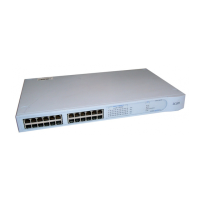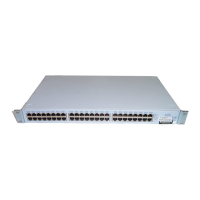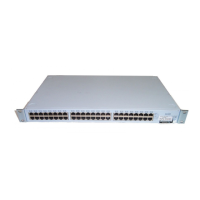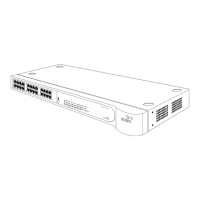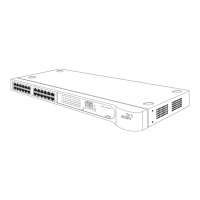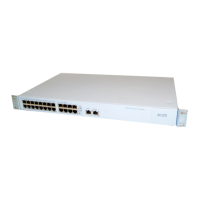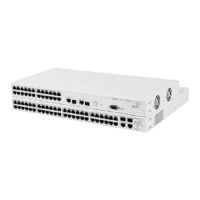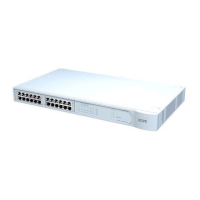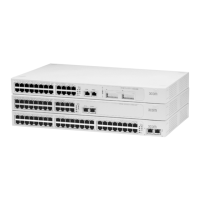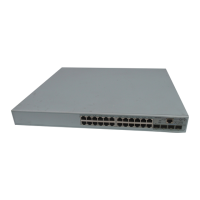Do you have a question about the 3Com 3CR17501-91 - SuperStack 3 Switch 3250 and is the answer not in the manual?
Lists conventions for notice icons and text formatting used throughout the guide.
Lists other guides and resources available for the switch for further information.
Provides information on how to submit feedback to improve the documentation.
Explains the role and benefits of using management software for switch configuration and monitoring.
Introduces key switch features and their applications for optimizing network performance.
Details how multiple links combine for increased bandwidth and redundancy in network connections.
Explains automatic negotiation for port speed, duplex mode, and flow control settings.
Describes how to save and restore switch configuration files remotely to a server.
Explains how to forward multicast traffic efficiently to specific endstations using IGMP snooping.
Details RSTP for network resilience against link failures and protection from network loops.
Explains Virtual LANs for logical network segmentation, enhancing management and security.
Details features for securing network ports based on MAC addresses or login authentication.
Explains IP routing as a method for distributing traffic across IP networks at Layer 3.
Explains full and half duplex modes for data transmission efficiency and potential throughput.
Details flow control mechanisms to prevent packet loss during network congestion.
Details how multiple member links combine for increased bandwidth and redundancy.
Explains the IEEE 802.3ad standard and Link Aggregation Control Protocol (LACP).
Explains IP multicast for efficient one-to-many and many-to-many communication.
Explains the process of forwarding multicast traffic only to registered endstations.
Describes IGMP as a system for registering endstations with multicast groups.
Explains RSTP for network resilience against link failure and protection from network loops.
Defines Spanning Tree Protocol (STP) and its role in path management.
Details how STP determines the most appropriate paths and blocks redundant ones.
Compares RSTP functionality and benefits over the legacy STP protocol.
Explains the purpose and structure of the switch database for packet forwarding decisions.
Describes the different states (Learned, Non-aging, Permanent) of entries within the switch database.
Explains how to prioritize time-sensitive and critical data for smooth network transfer.
Details classification methods (802.1D, DiffServ, IP Port) for prioritizing network traffic.
Defines RMON as an IETF standard for monitoring LAN/VLAN traffic and collecting statistics.
Explains how the Alarms group sets thresholds and sampling intervals to generate events.
Describes how the Events group creates logs and sends SNMP traps for RMON alarms.
Defines Virtual LANs and their role in logical network segmentation, enhancing management and security.
Outlines benefits like ease of device movement, security, and traffic control.
Explains support for VLANs using IEEE Std 802.1Q tagging for carrying traffic over single links.
Explains the need for routers or Layer 3 switches for inter-VLAN communication.
Describes automatic IP configuration via DHCP or manual IP configuration methods.
Explains the automatic IP configuration process using DHCP servers for network setup.
Details restricting management access to trusted IP addresses and specific network interfaces.
Explains using HTTPS for secure, encrypted access to the switch's web interface.
Explains using SSH for secure remote administration of the switch's command line interface.
Details ACLs for filtering traffic and limiting network access based on defined rules.
Explains port security modes (Static, Network Login) for controlling access to network ports.
Defines Network Login for port-based user authentication typically via RADIUS.
Outlines benefits of RADIUS for centralized, secure management login and administration.
Defines routing as distributing packets across potentially dissimilar networks using routers.
Defines IP routing as operating at the network layer (Layer 3) of the OSI model for packet delivery.
Outlines benefits like economy, optimal routing, and network resiliency.
Details how routers use routing tables to determine the best path for packet forwarding.
Explains how Layer 3 switching controls interaction between bridging and routing within a switch.
Outlines the necessary tasks for implementing IP routing, including VLANs and interfaces.
Discusses key protocols like RIP, UDP Helper, ARP, and ICMP for IP routing operations.
Details media specifications and cabling requirements for Gigabit Ethernet connections.
Explains topology rules and examples for setting up large-scale Fast Ethernet networks.
Covers Ethernet topology rules specific to full duplex operation for enhanced throughput.
Shows switch usage for dedicated desktop connections using VLANs and aggregated links.
Demonstrates a switch used as an edge switch with aggregation and Layer 3 switching for network optimization.
Explains the format and structure of IP addresses, including network and host parts.
Details how to divide networks into subnets and the critical role of subnet masks.
Explains the function of gateways for forwarding IP packets to remote network destinations.
Explains how VLSMs allow flexible subnetting for more efficient IP address space utilization.
Describes supernetting as a technique to reduce routing table size in large networks.
Lists conventions for notice icons and text formatting used throughout the guide.
Lists other guides and resources available for the switch for further information.
Provides information on how to submit feedback to improve the documentation.
Explains the role and benefits of using management software for switch configuration and monitoring.
Introduces key switch features and their applications for optimizing network performance.
Details how multiple links combine for increased bandwidth and redundancy in network connections.
Explains automatic negotiation for port speed, duplex mode, and flow control settings.
Describes how to save and restore switch configuration files remotely to a server.
Explains how to forward multicast traffic efficiently to specific endstations using IGMP snooping.
Details RSTP for network resilience against link failures and protection from network loops.
Explains Virtual LANs for logical network segmentation, enhancing management and security.
Details features for securing network ports based on MAC addresses or login authentication.
Explains IP routing as a method for distributing traffic across IP networks at Layer 3.
Explains full and half duplex modes for data transmission efficiency and potential throughput.
Details flow control mechanisms to prevent packet loss during network congestion.
Details how multiple member links combine for increased bandwidth and redundancy.
Explains the IEEE 802.3ad standard and Link Aggregation Control Protocol (LACP).
Explains IP multicast for efficient one-to-many and many-to-many communication.
Explains the process of forwarding multicast traffic only to registered endstations.
Describes IGMP as a system for registering endstations with multicast groups.
Explains RSTP for network resilience against link failure and protection from network loops.
Defines Spanning Tree Protocol (STP) and its role in path management.
Details how STP determines the most appropriate paths and blocks redundant ones.
Compares RSTP functionality and benefits over the legacy STP protocol.
Explains the purpose and structure of the switch database for packet forwarding decisions.
Describes the different states (Learned, Non-aging, Permanent) of entries within the switch database.
Explains how to prioritize time-sensitive and critical data for smooth network transfer.
Details classification methods (802.1D, DiffServ, IP Port) for prioritizing network traffic.
Defines RMON as an IETF standard for monitoring LAN/VLAN traffic and collecting statistics.
Explains how the Alarms group sets thresholds and sampling intervals to generate events.
Describes how the Events group creates logs and sends SNMP traps for RMON alarms.
Defines Virtual LANs and their role in logical network segmentation, enhancing management and security.
Outlines benefits like ease of device movement, security, and traffic control.
Explains support for VLANs using IEEE Std 802.1Q tagging for carrying traffic over single links.
Explains the need for routers or Layer 3 switches for inter-VLAN communication.
Describes automatic IP configuration via DHCP or manual IP configuration methods.
Explains the automatic IP configuration process using DHCP servers for network setup.
Details restricting management access to trusted IP addresses and specific network interfaces.
Explains using HTTPS for secure, encrypted access to the switch's web interface.
Explains using SSH for secure remote administration of the switch's command line interface.
Details ACLs for filtering traffic and limiting network access based on defined rules.
Explains port security modes (Static, Network Login) for controlling access to network ports.
Defines Network Login for port-based user authentication typically via RADIUS.
Outlines benefits of RADIUS for centralized, secure management login and administration.
Defines routing as distributing packets across potentially dissimilar networks using routers.
Defines IP routing as operating at the network layer (Layer 3) of the OSI model for packet delivery.
Outlines benefits like economy, optimal routing, and network resiliency.
Details how routers use routing tables to determine the best path for packet forwarding.
Explains how Layer 3 switching controls interaction between bridging and routing within a switch.
Outlines the necessary tasks for implementing IP routing, including VLANs and interfaces.
Discusses key protocols like RIP, UDP Helper, ARP, and ICMP for IP routing operations.
Details media specifications and cabling requirements for Gigabit Ethernet connections.
Explains topology rules and examples for setting up large-scale Fast Ethernet networks.
Covers Ethernet topology rules specific to full duplex operation for enhanced throughput.
Shows switch usage for dedicated desktop connections using VLANs and aggregated links.
Demonstrates a switch used as an edge switch with aggregation and Layer 3 switching for network optimization.
Explains the format and structure of IP addresses, including network and host parts.
Details how to divide networks into subnets and the critical role of subnet masks.
Explains the function of gateways for forwarding IP packets to remote network destinations.
Explains how VLSMs allow flexible subnetting for more efficient IP address space utilization.
Describes supernetting as a technique to reduce routing table size in large networks.
| Jumbo Frame Support | Yes |
|---|---|
| Product Type | Switch |
| Device Type | Switch |
| Layer | 2 |
| Form Factor | Rack-mountable |
| Status Indicators | power |
| Compliant Standards | IEEE 802.3, IEEE 802.3u, IEEE 802.3ab |
| Operating Humidity | 10% |
| Standards Compliance | IEEE 802.3, IEEE 802.3u, IEEE 802.3ab, IEEE 802.3x |
| MAC Address Table Size | 8000 entries |
